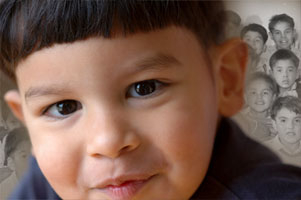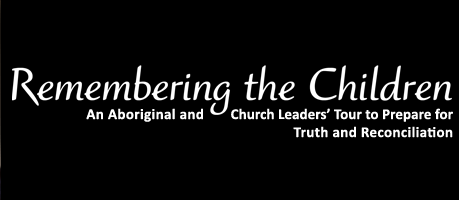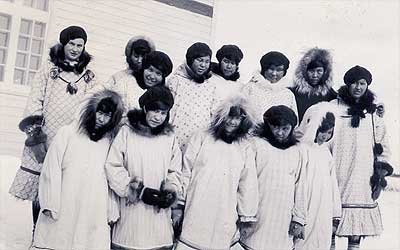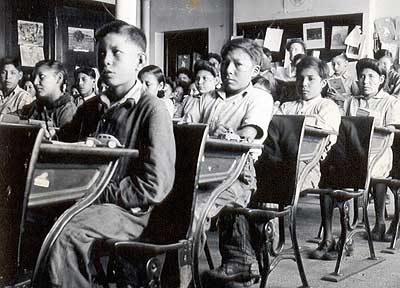

You are here:
Historical Sketch for Anglican Residential Schools
At various times between 1820 and 1969, the Anglican Church of Canada administered about three dozen Indian and Eskimo residential schools and hostels. At its peak involvement in the late 1920s, the Church concurrently operated 24 schools situated mostly in northern regions of central and western Canada. Some of these residential schools replaced or supplemented mission day schools, others were established in new areas replacing earlier boarding schools, and many were built by the government to be run by the Anglican Church. Canada’s other major Christian churches had similar roles in educating aboriginal peoples.
Prior to Confederation in 1867, Anglican missions in remote British North America had three primary objectives-- to evangelize local native populations, to administer to the sick and to provide basic schooling for the young. Many young Indians were thus baptized, confirmed by the Church, and educated in the European and Church traditions. On returning to their home communities, native adherents were expected to promote the appeal of Christian teachings and values. At the time, Church and colonial officials gave little thought to their assimilation into Canadian society at large.
Under the terms of the Constitution Act of 1867 and subsequent Indian Act of 1876, the new Canadian government assumed its responsibility for Indians and soon adopted aggressive policies with regard to the regulation, education and ultimate assimilation of the Indians. Similar policies affecting the Inuit groups would take place later, due in part to Britain’s delay in relinquishing control of the arctic and on account of the difficulties in administering to these remote and nomadic peoples.
The spate of newly signed numbered treaties with first nations groups in the west also spoke to the government’s obligation to provide schooling. Initially, many aboriginal leaders supported efforts to educate their people, in spite of the curricula imposed by church and government. Several generations would pass before native groups found sufficient solidarity to effectively challenge the prevailing system and expose the abuse and loss of culture suffered by former residential school students.

ALL SAINTS INDIAN RESIDENTIAL SCHOOL
(AKLAVIK, NWT), P75-103 S7-87,ca.1937.
General Synod Archives.
For government, the ultimate goal remained the assimilation of educated native peoples into the non-aboriginal world. The procedure was known as enfranchisement, by which graduates of the system would apply and qualify for citizenship. In doing so, they would lose their Indian status and benefits but, with a small start-up grant, they were expected to succeed in the mainstream world of the Canadian/European society. Successive Parliaments endorsed policies that sanctioned the removal of native children from their “evil surroundings” of family and community and subjecting them to the re-socializing programs in the schools. In the blunt language of a century ago, Ottawa’s policy was simply stated—“the ‘savage’ child would surely be re-made into the ‘civilized’ adult.”
The vast majority of children attending residential schools were “status Indian” (as defined by the Indian Act). Many students of mixed blood and some from families of indigent white settlers were also accommodated by authority of the local Indian Agents. By World War I, the government had developed standards for school buildings and instituted a prescribed schedule of per capita grants. After 1928, Canada’s native population was on the rise again, after decades of decline caused by rampant disease outbreaks attributed to contact with the European community. New and expanded schools were needed to deal with the growing backlog of native children destined to be educated in residential schools.
Maintaining the authorized pupilage was a challenge for principals when school commenced each fall. Students from distant reserves often arrived late or were kept home by parents. Some were lured by non-Anglican missions to attend their schools. The influenza and tuberculosis pandemics early in the 20th century also took a toll on enrolment. Conversely, the school’s quota was often exceeded when principals accepted orphaned children, native and non-native. Students in the Anglican schools were supported materially and financially by the Missionary Society of the Church of England in Canada (MSCC), the Women’s Auxiliary (WA) and by non-native parishes who were asked to sponsor a child.
“Graduation” at most schools meant completing grade 8, with a strong emphasis placed on vocational skills for boys and girls (e.g. farming, sewing, cooking). Following World War II, there were increasing opportunities for secondary education within the residential schools, usually in partnership with local public high schools. As well, first nations groups slowly began to establish their own elementary and secondary day schools near reserves. By the 1960s, most Anglican residential schools had become dormitories for aboriginal students who attended primary and secondary day schools in the local communities.

OLD SUN INDIAN RESIDENTIAL SCHOOL (GLEICHEN,
AB), P75-103 S7-184, 1945, General Synod Archives.
After World War II, Ottawa began to question the prevailing practice of church-state run education for aboriginal peoples. The Anglican Church launched its own study of the matter in 1946, undertaken primarily to determine the viability of its own schools and to identify shortcomings in educational standards. By 1952, Ottawa was responsible for hiring all teachers and had complete control over in-class curriculum, which was the prevailing standard in the public schools. The status quo continued in the short term as more government hostels (with church administrators) were still being planned, many to serve Inuit children. By the early 1960s, the churches and government concluded that the residential school system had failed. On April 1, 1969, the remaining church-run hostels and residential schools were taken over by the government who planned to close them as soon as possible or turn them over to first nations groups.
In this post-war era, native issues were high on the public agenda as aboriginal groups found a forum to raise their concerns. Successive amendments to the Indian and Constitution Acts and landmark court decisions removed discriminatory practices, restored rights and provided a new empowerment for native groups.
In the two decades since the late 1980s, many residential school survivors have come forward with stories of their experiences, including physical and sexual abuse and the impact of their loss of culture. During this period, government and religious bodies have partnered in programs to assist not only the school survivors but the native population in general. In 1991, the Royal Commission on Aboriginal Peoples was convened to examine many unresolved issues and make recommendations to foster a fair and honourable relationship between Aboriginal and Non-Aboriginal peoples in Canada. Also in 1991 the Anglican Church established an Indigenous Healing Fund to support the healing work undertaken by local aboriginal communities and groups. In his 1993 address to the National Native Convocation, the Anglican Primate, Archbishop Michael Peers offered a full apology for the Church’s role in being a part of the system and for the wrongs committed. In 1998, the native-run Aboriginal Healing Foundation was created to manage the healing strategy and to complement existing government, church and first nations programs.
Government and aboriginal groups continued to seek solutions to address the legacy of the residential school experience and to provide satisfactory compensation for survivors. Negotiations culminated with the Residential Schools Settlement Agreement in Principle announced on November 23, 2005 and its implementation on September 19, 2007. Former students were given the opportunity to opt out and pursue independent litigation. However, First Nations leaders and government expect the large majority of former students to accept the Common Experience Payment and additional amounts for each year they were in residence. In 2005, there were an estimated 80,000 living school survivors.
The Settlement Agreement also provided funding for several healing initiatives, among those the establishment of a Truth and Reconciliation Commission and research centre.
Compiled by General Synod Archives. February 21, 2008.